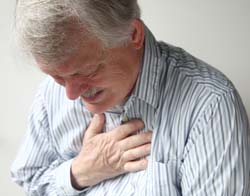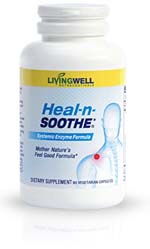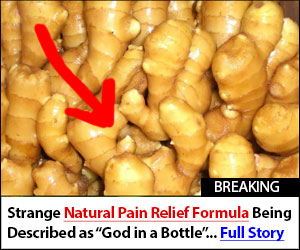
Is it just indigestion, or a real cause for concern?
What is that intense and tightening pain in your chest? Is it something serious or just a bad case of indigestion?
You’ve probably experienced the discomfort of chest pain. It can radiate anywhere along the front of your body from your neck to your upper abdomen.
What is the cause of your chest pain? The list of potential causes is long. Some are not hazardous to your overall health while others can be life-threatening.
You might experience a sharp, dull, burning, stabbing, or aching pain. Sometimes it’s a tight, squeezing or crushing sensation.
The source of your pain can be the organs or tissue in your chest including your heart, muscles, lungs, esophagus or nerves.
When chest pain persists, it’s a good idea to have a thorough medical examination. Symptoms can be warnings of serious medical conditions.
Dangerous Diseases Signaled by Chest Pain
#1 Coronary Heart Disease
Coronary heart disease, the narrowing of the arteries that supply oxygen and blood to your heart, is the leading cause of death in the U.S. for both men and women. And it may be the reason for your chest pain.
When fatty material and other substances form a plaque build-up on the walls of your coronary arteries, the restriction of blood flow to your heart can result in a fatal heart attack.
If you have severe, crushing pain in your chest, sweating, nausea, and severe weakness, these are classic signs of a heart attack. A heart attack is always an emergency that requires immediate medical attention.
While a heart attack is the most recognized chest pain danger signal, many dangerous heart conditions can lead to chest pain including:
- Angina – Blockage in the heart blood vessels.
- Pericarditis – Inflammation or infection of the sac around the heart.
- Mitral valve prolapse – Valve in the heart that fails to close properly.
- Coronary artery dissection – A tear in the coronary artery.
- Hypertrophic cardiomyopathy – Thickening of the heart muscle.
#2 Lung Disease
Your lungs have the important function of taking oxygen from the air you breathe and delivering it to your bloodstream. You breathe about 25,000 times every day just to provide the cells in your body with the oxygen they need to work and grow.
Altogether, lung disease is the third leading cause of death following only heart disease and cancer. Any type of lung disease can jeopardize your oxygen supply. Some of the more common painful lung conditions include:
- Asthma – Inflammatory disorder that causes shortness of breath, wheezing, and coughing.
- Pneumonia – Infection in the lungs that can lead to inflammation of the lung tissue or surrounding tissue. Comes on suddenly, causing fever, chills, and coughing.
- Pulmonary Embolism – Blood clot that travels through the bloodstream to the lungs, resulting in sharp chest pain, trouble breathing, rapid heartbeat, fever and shock.
- Pleuritis – Inflammation or irritation of tissues that line the lungs and chest.
#3 Gastrointestinal Disease
Heartburn has you reaching for the antacid again? This common source of chest pain could be a sign of gastroesophageal reflux disease (GERD).
GERD, or acid reflux, occurs when your stomach contents flow backward into your esophagus, causing that burning chest pain. This acid backwash can irritate the lining and cause serious damage to your esophagus.
Several other gastrointestinal conditions also cause chest pain including:
- Pancreatitis – Inflammation of the pancreas that radiates pain in your lower chest.
- Peptic ulcers – Sores in the lining of the stomach or first part of your small intestine.
- Gallbladder problems — Gallstones or inflammation of your gallbladder that can cause pain in your lower right chest area or the right upper side of your abdomen.
Tips to Prevent Chest Pain and Related Diseases
Did you notice virtually every condition I mentioned is related to inflammation in some way? Controlling inflammation in your body should be your first step towards preventing – or recovering – from many of these severe diseases.
First of all, never underestimate the importance of good nutrition and exercise. Regular exercise in conjunction with a healthy diet full of anti-inflammatory foods can help control the widespread inflammation behind heart disease, lung disease and many gastrointestinal conditions.
Injury, overused muscles, tension and stress often play a role in chest pain and even conditions like heart disease. Practice reducing muscle strain and reversing the stress and anxiety in your life. Not sure where to start? Here’s one of the simplest ways I know for fast stress relief that helps you calm and control both your body and mind.
Finally, consider taking all-natural Heal-n-Soothe® to safely rid yourself of chest pain… by helping eliminate many of the potentially dangerous conditions behind it.
Heal-n-Soothe® is a powerful natural anti-inflammatory. This alone will help reduce pain of all kinds, without the harmful side effects of the over-the-counter or prescription anti-inflammatory medicines you may have taken to deal with your pain.
But Heal-n-Soothe® also plays a special role in reducing the big risk factor behind heart attacks and strokes: blood clots. Proteolytic enzymes in Heal-n-Soothe® break down and sweep away excess clot-forming fibrin from your blood vessels, reducing your risk from dangerous clots.
Once these blockages are cleared away, oxygen- and nutrient-rich blood can flow to damaged tissues, giving your cells the tools they need to repair your body while helping your blood carry away toxins and other metabolic waste products out of your system.
Protect yourself and get relief from many of the major causes of chest pain by trying Heal-n-Soothe® today.
Fight Back Against Inflammatory Chest Pain!

Try a bottle of Heal-n-Soothe® today!
References
- U.S.Department of Health and Human Services. Chest Pain. National Library of Medicine: National Institute of Health. 2011 May 23.
- Coronary Heart Disease.NationalCenter for Biotechnology Information. National Library of Medicine: National Institute of Health. 2011 May 23.
- U.S.Department of Health and Human Services. Lung Diseases. National Library of Medicine: National Institute of Health. 2012 May 19.
- U.S.Department of Health and Human Services. Gastroesophageal Reflux Disease. National Library of Medicine: National Institute of Health. 2011 Aug 11.



sounds like this might help another scary painful chest pain condition for which recent doctor’s visit gave no recommendations expecting it to go away on it’s own.
Costochondritis – inflammation of the junctions where the upper ribs join with the cartilage that holds them to the breastbone or sternum in which there is no swelling,
Tietze (pr. “teet – see”) syndrome is accompanied by a localized swelling at the the junction of the ribs and breastbone.
Thamk you Irene!!
thank you! :))